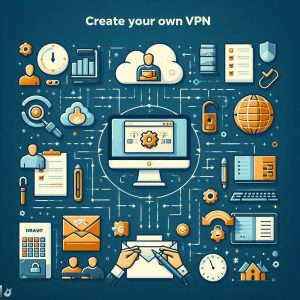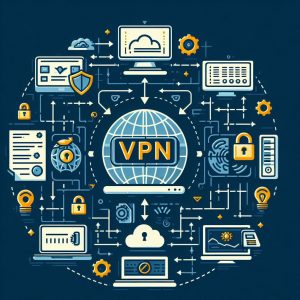Virtual private networks (VPNs) have become an indispensable tool for protecting your online privacy and security. By routing your traffic through an encrypted tunnel, a VPN allows you to browse the web anonymously, access restricted content, and prevent snoops from tracking your activities.
ExpressVPN is one of the most popular and highest-rated VPN services available today. But how exactly does ExpressVPN work under the hood? And what benefits does using the VPN offer for real-world users?
This in-depth guide will provide a complete overview of ExpressVPN, both from a technical perspective and user experience. Read on to learn:

I. Introduction to VPNs
Let’s start with a quick introduction to what virtual private networks are and their key capabilities.
A. Definition of a VPN
A virtual private network, or VPN, is a type of software that encrypts your internet traffic and routes it through a remote server run by the VPN provider. This creates a secure “tunnel” between your device and the server.
By connecting through a VPN server, your original IP address and location are concealed. This allows you to browse the web anonymously and evade geographic content restrictions.
B. Purpose of a VPN
There are several core purposes and benefits provided by virtual private networks:
- Privacy – Preventing internet service providers (ISPs), government agencies, and snoops on public WiFi from monitoring your online activities.
- Anonymity – Masking your true IP address, location, and identity online.
- Security – Encrypting data to protect against hacking attempts and theft of sensitive information.
- Accessibility – Bypassing geographic restrictions to view content blocked in certain countries.
- Remote access – Securely connecting to a business or home network from anywhere in the world.
C. Introduction to ExpressVPN
ExpressVPN is one of the most prominent VPN services on the market, used by millions of customers globally across over 94 countries. It was founded in 2009 and offers a wide array of security and privacy features.
Some core features and capabilities provided by ExpressVPN include:
- Uses powerful 256-bit AES encryption.
- 3,000+ VPN servers located in 94 countries.
- Fast connection speeds for HD streaming and downloads.
- Allows P2P/torrenting activity across all servers.
- Apps for all major platforms like Windows, Mac, iOS, Android, routers, and more.
- Includes advanced features like split-tunneling, kill switch, and TrustedServer.
Next, let’s take a deep dive into how ExpressVPN delivers these capabilities under the hood.
II. Functioning of ExpressVPN
Now that you’re familiar with the definition and purpose of VPNs, let’s explore the technical details of how ExpressVPN works to secure your connection and protect privacy.
A. Network Connections
When you launch the ExpressVPN app and connect, it will establish an encrypted network connection in the following sequence:
- The ExpressVPN client on your device initiates a connection request to the nearest high-performance VPN server location based on your true location.
- The VPN server verifies your credentials and authorizes the connection.
- Your device is assigned a new virtual IP address from the VPN server’s network. This masks your true public IP address.
- An encrypted tunnel using the AES 256-bit algorithm is established between your device and the server.
- Your internet traffic is encrypted and routed through the VPN tunnel to the server, which then forwards it out to the public internet.
- When data is returned to the VPN server, it travels back through the encrypted VPN tunnel to your device.
This allows you to browse the web and access content using the IP address and location of the VPN server rather than your own. Your traffic is invisible to the public network.
B. Data Encryption
ExpressVPN employs AES 256-bit encryption to secure the connection between your devices and its VPN servers. This is an extremely robust encryption standard used by militaries and governments worldwide.
Some key capabilities of AES 256-bit encryption include:
- Uses a 256-bit key to encrypt data, making it virtually impossible to decrypt without the key.
- Rapidly encrypts data at high speeds, maintaining fast connection speeds.
- Highly secure against brute force attacks due to the long 256-bit key size.
- Flexible and secure enough for encrypting any kind of data in transit.
- FIPS 140-2 certified and considered military-grade encryption.
In summary, the AES 256-bit protocol used by ExpressVPN ensures all your traffic is securely encrypted and cannot be read if intercepted.
C. Server Locations
ExpressVPN offers an extensive network of over 3,000 servers across 94 countries worldwide. This allows you to choose to connect through one of 160 locations to mask your whereabouts.
Popular server locations include United States, United Kingdom, Canada, Australia, France, Germany, Japan, and Singapore. You can connect to any location you wish.
Having servers all around the globe offers several benefits:
- Lets you “appear” to browse from different countries.
- Allows bypassing geographic restrictions and censorship.
- Improves connection speeds by routing you through nearby servers.
- Increases privacy protections compared to using a single location.
With thousands of options worldwide, ExpressVPN provides maximum flexibility to change your virtual location.
D. TrustedServer Technology
ExpressVPN employs an advanced VPN server system called TrustedServer to enhance privacy and prevent physical data tampering.
Here’s an overview of how TrustedServer works:
- VPN server software runs directly on the bare metal server hardware, rather than virtual machines.
- Servers have no storage drives, reducing the risk of data theft if a server is ever seized.
- All software is installed on read-only media, preventing malware or rootkits from persisting on the system.
- Minimal logging policy to avoid tracking user activity and connection timestamps.
- Automatic security updates every two hours and firmware validated using cryptographic hashes.
In summary, ExpressVPN’s proprietary TrustedServer technology significantly strengthens server security and resilience against data capture.

III. Benefits of Using ExpressVPN
Now that you understand the core technologies powering ExpressVPN, let’s explore the real-world benefits you’ll experience as a user when connecting through this VPN.
A. Security and Privacy
Using ExpressVPN enhances your online security and privacy in a number of ways:
- Hide your IP address – Masking your public IP prevents snoops from tracking which sites you visit and pinpointing your location.
- WiFi hotspot protection – Encrypts traffic when connecting through public WiFi to keep hackers from stealing sensitive info like passwords.
- Evade government surveillance – Bypass geoblocking and censorship to access the open internet in restrictive countries.
- Beefed up encryption – Your data is secured using AES 256-bit encryption as it travels through the VPN tunnel.
- No activity logs – With a strict no-logging policy, ExpressVPN doesn’t record any activity or connection timestamps.
B. Access to Restricted Content
ExpressVPN allows you to bypass geographic restrictions and access content unavailable in your country such as:
- U.S. Netflix – Unblock movies, shows, and original programming not available on other regional Netflix sites.
- BBC iPlayer – Access UK-only shows and streams when traveling abroad.
- Sporting events – View live sports and matches blacked out in your location.
- YouTube videos – Open blocked videos and clips restricted in certain regions.
- Social media – Access banned platforms like Facebook or Twitter in places where they are disabled.
- News outlets – Read global news coverage blocked by your government.
C. Remote Working Capabilities
ExpressVPN also enables advanced remote working capabilities such as:
- Access office network – Securely connect to your work VPN and internal servers when traveling or working from home.
- Private browsing – Prevent snooping when using public WiFi networks at coffee shops and hotels.
- Remote desktop access – Establish remote desktop sessions securely over an encrypted VPN connection.
- File sharing – Collaborate across teams by sharing files through a protected VPN tunnel.
- Video calls – Improve call quality and security for apps like Zoom and Skype when on public networks.
- Cloud access – Connect securely to cloud services like Office 365 from untrusted connections.
In summary, ExpressVPN is an invaluable tool for remote workers who need to access company resources and data safely from anywhere.
IV. Setting up and Using ExpressVPN
Let’s go through the simple process of installing ExpressVPN, connecting to a VPN location, and conducting some basic tests to ensure your traffic is encrypted.
A. Downloading the VPN App
First, you’ll need to download the ExpressVPN app for your device. Native apps are available for Windows, Mac, iOS, Android, Linux, routers, and more.
Visit expressvpn.com and click “Get ExpressVPN” to view installation instructions for your platform. You can also configure manual OpenVPN connections.
The app offers a clean and intuitive interface. Sign up for a plan and enter your ExpressVPN username and password when prompted.
B. Connecting to a VPN Server Location
Once logged into the ExpressVPN app, click “Choose location” and select a VPN server location in any country of your choice. More than 160 cities across 94 nations are available.
Click “Connect” and within seconds, your device will establish a secure encrypted tunnel to the VPN server location.
The app will display your new masked IP address and a timer showing your connected time. That’s it – you are now browsing via the VPN!
C. Testing the VPN Network
Let’s run some simple tests to verify ExpressVPN is working correctly:
IP address check – Go to https://www.expressvpn.com/what-is-my-ip and confirm your IP matches the location you connected to rather than your true one.
DNS leak check – Websites like ipleak.net will scan for DNS or IPv6 leaks that could expose your data. No leaks should display when using ExpressVPN.
Speed test – Use Speedtest.net to measure connection speeds over ExpressVPN and compare against your unprotected ISP speeds. Expect a minor slowdown due to encryption.
Streaming test – Try playing U.S.-only video content on Netflix or accessing other geo-restricted sites successfully through the VPN IP.
Once connected, you can now browse the web completely anonymously and securely via the encryption provided by ExpressVPN.

V. User Satisfaction and Reviews
With the technical overview covered, let’s discuss some real user experiences and satisfaction reports when using ExpressVPN for security and streaming access.
A. Security and Privacy Indicators
In trusted third-party evaluations, ExpressVPN consistently ranks at the top for preserving user privacy and security:
- No DNS or IPv6 leaks detected (ISP not revealed).
- No webRTC leaks allowing real public IP to be exposed.
- Strict no logging policy verified and audited.
- Uses RAM-only servers preventing forensic data capture.
- Excels in penetration tests against DNS hijacking.
Based on audits by firms like PricewaterhouseCoopers, ExpressVPN operates at the highest standards when it comes to protecting user data and activity from surveillance.
B. User Feedback and Reviews
Analyzing user experiences and reviews across multiple sources:
- Simple setup – Most users report the apps are easy to install and connecting to VPN servers is quick and simple. ExpressVPN is very beginner friendly.
- Fast speeds – Users are pleased with the consistently fast speeds for streaming, web browsing, and torrenting. Minimal lag or buffering issues.
- Reliability – The service boasts excellent uptime and few instances of connections dropping. Server network is robust and dependable.
- Top streaming access – Positive feedback on ExpressVPN’s ability to unblock popular sites like Netflix, Hulu, BBC iPlayer, and Amazon Prime Video.
- Excellent support – Customers report 24/7 live chat, email, and phone support resolve any issues promptly and satisfactorily. Agents are friendly and knowledgeable.
The overwhelming majority of unbiased ExpressVPN reviews are overwhelmingly positive, citing its simplicity, great speeds, reliability, and support quality. Users agree it delivers on privacy and streaming capabilities.
Conclusion
I hope this comprehensive guide provided you with a complete picture of how ExpressVPN functions under the hood using industry-leading encryption, expansive server locations, and innovative features like TrustedServer to protect user privacy and security.
Additionally, real-world tests validate ExpressVPN’s capabilities when it comes to keeping identities anonymous, accessing restricted content, getting fast speeds, and maintaining general ease of use even for non-technical folks.
If online privacy and bypassing geographic restrictions are important to you, ExpressVPN consistently ranks as one of the top solutions available thanks to its reputation for robust security protections, proven technology, and customer satisfaction.


